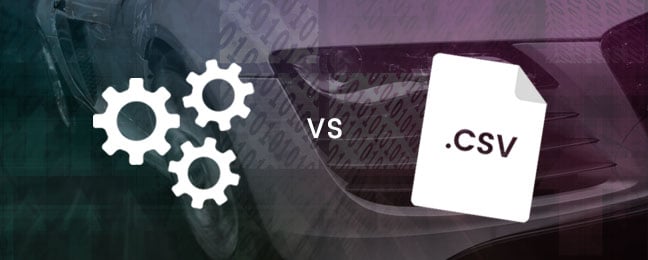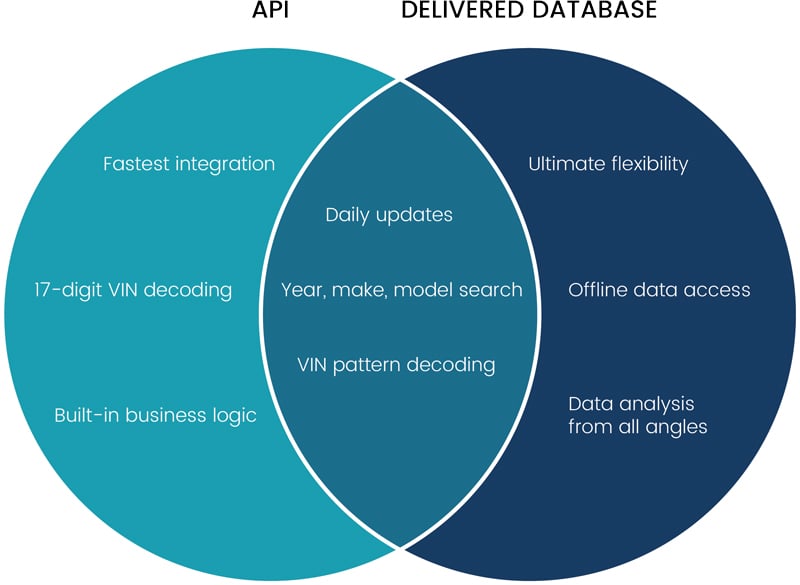

Oct 8 2024
Have you been tasked with picking the best vehicle data and VIN decoding solution for your new business venture or a new product at your current company? There are many things you need to consider when choosing a VIN data solution, such as the depth and breadth of vehicle data coverage, accuracy of the data, pricing, and, as discussed in this article, delivery options.
There are two primary ways to access and leverage VIN data: through a web service API or through delivered flat files. Which one is the right choice? Is one option better than the other? This all depends on these 4 big questions:
How will the data be used?
What level of information are you looking to obtain for each vehicle?
What is the timeline and development budget for launching your new business or products?
How much flexibility do you need?
In this article, we’ve provided the major benefits of each delivery option and addressed these four questions to help make your decision easier.
You are likely familiar with Application Programming Interfaces (APIs). You’ve probably worked with several APIs throughout your programming or project/product management career. There are many advantages to leveraging a VIN decoder API, including the following:

A VIN decoder API will typically take less time to integrate into your products than delivered vehicle database flat files. Since the business logic has already been developed, it’s just a matter of knowing how to work with APIs. This will still require some development, but not as much as working with a delivered database. Additionally, working with a delivered database will require more automotive data knowledge to ensure the correct business rules are implemented.
Some of the more comprehensive VIN decoder APIs, including DataOne’s API, will utilize advanced 17-digit VIN decoding business logic. Additionally, these APIs will support external data inputs (manufacturer codes and raw DMS data) for a more precise VIN decode. Learn more about this subject in one of our previous articles, “Why You Shouldn’t Settle for a VIN Decoder That Just Decodes the VIN.”
Delivered databases may seem antiquated and in many ways inferior to an API. Many software/technology companies don’t even offer a delivered data option, given the efficiency of APIs and their ability to monitor and control user consumption. However, there are certainly still some advantages that a delivered vehicle database has going for it:
With a delivered vehicle database, the data can be hosted in-house, which will give your business the ability to access the data in an offline environment.
The delivered vehicle database option will also give users ultimate flexibility to query the data however they want. Raw vehicle data from delivered flat files is great for analyzing the data from any angle. This simply cannot be done with an API.
Here's a diagram for a quick comparison:

Both options offer benefits, but is there one that is superior? Let’s look at the questions presented at the beginning of the article:
Will the VIN decoder or vehicle data be consumer-facing or used for internal purposes only? Are there any instances where you may need to decode VINs in an offline environment? Your intended application for VIN decoding will play a big role in choosing the best delivery option for you. For example, A VIN decoder API would be easiest for plugging into your site or software, whereas a delivered vehicle database will allow you to host all the data on your servers and decode VINs offline if necessary.
If the amount of vehicle information you need to obtain from each VIN is minimal (year, make, model, trim, engine, drive type, etc.), both the API and delivered flat files will get the job done. However, if you can gain value from extremely precise VIN decoding, returning as much info about each vehicle as possible, you’ll want to go with an API that has some built-in business logic, as touched upon earlier
If you are looking for rapid development of your new products or hoping to prove up a new business model quickly, a VIN decoder API will probably be the best option for your business, as all the business logic is included. Delivered flat files will not be as efficient and will require some extra development as well as additional automotive data knowledge, which brings me to the last question…
As mentioned, a delivered vehicle database is a great option if you want to have the ability to thoroughly analyze the data from any angle. There is quite a bit of flexibility with a VIN decoder API as well, but if you want to build something unique, a delivered database will be the best option.
Both VIN decoder APIs and delivered vehicle databases have many unique benefits, as well as shared benefits, to consider as you weigh which option is best for your business. We still see the value in giving our customers the choice to pick one or the other, or even leverage both as a hybrid solution for different aspects of your business/products.
We’d be happy to assess your needs and provide our recommendations!